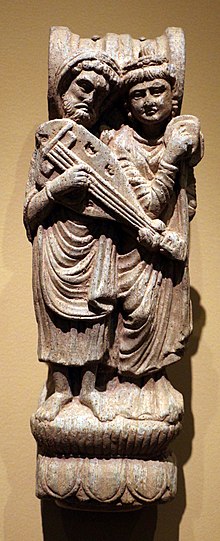This vaulted bracket, with acanthus leaves on the side, is decorated with a musician-couple who stand on a lotus pedestal. The bearded male plays a sitar-like instrument, while his companion holds a clapper-type percussion instrument similar to the kartal (still used today to accompany dancing in some parts of India, such as Orissa).
Both figures are clad in heavily draped robes that consist of two garments: an outer one---like the Classical himation---and the inner one, ankle length on the male and floor length on the female. The man's head is covered with a cap or a hood, while the young woman wears her hair pulled into a chignon and decorated with a garland, in a fashion more appropriate for a lady. She also wears heavy earrings.
The bracket or corbel of this type, originally probably placed fairly high, seems to be a particularly appropriate component for being decorated with celestial, heavenly musicians.
The style that it represents makes one think of the Romanesque or Gothic sculpture of medieval Europe. It is quite characteristic for the Swat area, particularly around Batkara, where Domenico Faccenna conducted extensive archaeological excavations.
A number of comparable pieces, including voluted brackets, are decorated with acanthus leaves and figures of diverse type, some of which are celestial musicians who hold the same instruments.
The facial types represented here are almost identical to some of the figures from Batkara.




 French
French Deutsch
Deutsch

